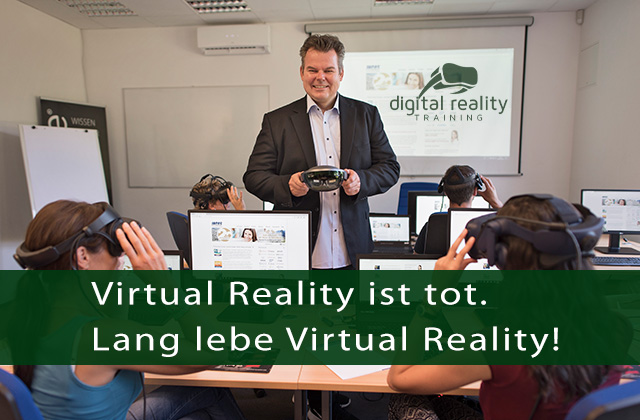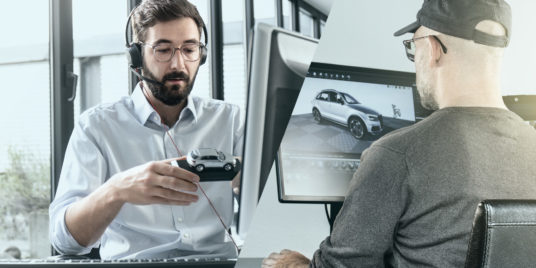Virtual Reality ist tot. Lang lebe Virtual Reality!

English Version below
„Wir erleben gerade das Ende um den Virtual Reality Hype.“
Kürzlich habe ich – wieder einmal – folgenden Satz gelesen: „Wir erleben gerade das Ende um den Virtual Reality Hype.“ Mein erster Gedanke: Moment, das kommt mir doch irgendwie bekannt vor. Kurz gegoogelt und tatsächlich. Seit Januar 2016 (dem eigentlichen Beginn des Hypes) erscheinen in regelmäßigen Abständen von einigen Monaten immer wieder die gleichen Artikel. Die Schlagzeilen unterscheiden sich kaum:
„Virtual Reality – Das war’s dann wohl mit dem VR-Hype.“
„Der Techtrend, auf den Mark Zuckerberg voll setzt, ist tot.“
„Das Ende von Virtual Reality“
„VR-Entwickler: ‚Wir erleben gerade das Ende des Hypes‘“
Das scheint ein langer Tod zu sein, wenn er sich schon über so geraume Zeit hinzieht. Gleichzeitig begegnen mir aber in ebenso regelmäßigen Abständen Berichte über den bevorstehenden Durchbruch zur Massenware VR. Der sorgfältige Beobachter bleibt verwirrt zurück. Was denn nun? Ist Virtual Reality schon tot oder noch gar nicht erst geboren?
Tatsächlich scheint beides zuzutreffen. Es stimmt, dass die Marktentwicklung von VR hinter einigen Erwartungen zurückbleibt. VR kann sich auf dem Massenmarkt noch nicht behaupten, dabei sollte 2018 doch schon jeder dritte Deutsche eine Virtual Reality Brille besitzen – faktisch sind es aber nur 6%. Der „Misserfolg“ führt dazu, dass die Investitionen knapper ausfallen: Start-Ups geht die Luft aus und sie schlittern in den Konkurs.
Also doch das Ende eines Traums?
Möglicherweise ja, aber nach dem Traum erfolgt das Erwachen – und das muss nicht unbedingt schlecht sein. So ist das nun mal bei Hypes: Erst sind die Erwartungen riesengroß und VR ist plötzlich die Lösung für alles. Dann folgt der ernüchternde Fall ins tiefe Tal („Wie, Virtual Reality hat die Gesellschaft innerhalb von zwei Jahren nicht grundlegend geändert? Dann ist die Technologie eh tot!“) und schließlich finden wir uns irgendwo dazwischen, in einer gesunden goldenen Mitte wieder.
Fakt ist: Die Geschichte von Virtual Reality hat gerade erst begonnen. Mit der Oculus Go ist in Deutschland erst Ende Juni ein massentaugliches Produkt auf den Markt gekommen, das sich laut Llamas von Superdata Research im Startquartal besser verkauft als die Oculus Rift in der gesamten ersten Jahreshälfte 2017. Das Angebot der Brillen wächst. Und auch die Anwendungsbereiche weiten sich aus.
Wie gehe ich also als Unternehmer mit dieser Erkenntnis um?
Zunächst einmal: Seid innovativ! Es setzt sich zunehmend die Erkenntnis durch, dass Virtual Reality kein Selbstzweck sein kann. Es gilt, die Technologie so einzusetzen, dass sie einen tatsächlichen Mehrwert bietet. Und dass VR das Potenzial dafür hat, ist unumstritten. VR sollte bestehende Möglichkeiten also nicht nur verbessern, wie es etwa beim Hype um den 3D-Fernseher der Fall war. Es reicht nicht, Bestehendes einfach nur etwas besser zu präsentieren. VR sollte viel eher dazu genutzt werden, völlig neue Anwendungen zu erfinden und tatsächlich neue Welten zu erschaffen.
Es fehlt einfach noch an hochwertigem Content um VR massentauglich zu machen.
Wenn das gelingt – und ich bin mir sicher, dass dem so ist – ist Virtual Reality mehr als nur ein Hype. Sondern eine Technologie, die sich langsam aber stetig entwickelt.
Seid realistisch!
Außerdem: Seid realistisch! Einerseits gilt zwar: Der frühe Vogel fängt den Wurm, andererseits hat man bei einem sich langsam entwickelnden Markt eine lange Durststrecke vor sich. So langweilig es klingt: Behutsame Investitionen, kalkuliertes Risiko und viel Geduld sind gefragt.
Das erste iPhone kam 2007 auf den Markt und wurde bis Ende 2007 gerade mal 1,4 Millionen mal verkauft. Gute Erfindungen brauchen nun mal ein paar Jahre Reifeprozess. Ein weiteres Beispiel: Herbert Simon, KI-Forscher und Nobelpreisträger, prognostizierte, dass Computer Schachweltmeister werden. Damit hatte er Recht. Allerdings stammte die Prognose aus dem Jahre 1957 und bezog sich auf die nächsten zehn Jahre.
Manchmal hilft es, sich auf den Spruch „Gut Ding will Weile haben“ zurückzubesinnen. Oder, um die Phrasendreschmaschine noch weiter anzukurbeln, Rom wurde auch nicht an einem Tag erbaut.
English Version
Virtual Reality is dead, long live Virtual Reality!
Recently I read sentence “VR is dying” …again. My first thought was: “Wait, that sounds quite familiar.” A quick research and, in fact, similar articles have been published at regular intervals of several months since January 2016 – the actual beginning of the hype. The headlines hardly differ from each other:
“Virtual reality: All hype and no substance?”
“Is virtual reality already dead?”
“This VR cycle is dead”
“Why the Virtual Reality hype is about to come crashing down”
That must be a long death, since it goes on for years. At the same time, however, I come across reports about the imminent breakthrough of Virtual Reality as a mass product, again and again. The careful observer remains confused. What now? Is Virtual Reality already dead or not even born yet? In fact, both seem to be true. It’s true that the market development of Virtual Reality failed to live up to some expectations. VR can’t assert oneself on the mass market, although by 2018 one in three Germans should already own Virtual Reality Glasses – but in fact it’s only 6%. The “failure” leads to lower investments: Start Ups run out of air and they go bankrupt.
So it is the end of a dream after all?
Possibly yes, but after the dream the awakening takes place – and that doesn’t necessarily have to be bad. That’s the way it is with hypes: First the expectations are huge and Virtual Reality is suddenly the solution for everything. Then follows the disappointment and disillusionment (“What? Virtual Reality has not fundamentally change society within two years? Then the technology is dead anyway!”) and finally we find ourselves somewhere in between, in a healthy golden mean.
The fact is that the story of Virtual Reality has only just begun. Just as recently as May this year a mass-suitable product was launched on the market – the Oculus Go. In May! That’s only four months! According to Llamas, the Vice President of strategy at SuperData Research, the product sold better than the Oculus Rift in the first half of 2017. The range of Virtual Reality Glasses is growing just as much as the areas of application.
So how do I, as an entrepreneur, deal with this area of tension?
First of all: Be innovative! There is a growing recognition that virtual reality cannot be an end in itself. It is important to use the technology in such a way that it offers real added value. And it is undisputed that VR has the potential to do so. VR should not only improve conventional possibilities, as it was then the case with the hype about the 3D television. It is not enough simply to present what already exists in a more attractive way. VR should rather be used to invent completely new applications and actually create new worlds.
There is still a lack of high-quality content to make VR suitable for mass production. If this succeeds – and I’m sure it will – Virtual Reality will be more than just a hype. It is a technology that is developing slowly but steadily.
Be realistic!
Also: Be realistic! On the one hand, it is true: The early bird catches the worm. But on the other hand the second mouse gets the cheese. As boring as it sounds: Cautious investments, calculated risk and a lot of patience are required.
The first iPhone was launched in 2007 and sold just 1,5 million units by the end of 2007. Good inventions take a few years to mature. Another example: Herbert Simon, AI researcher and Nobel Prize winner, predicted that computers would become world chess champions. He was right about that. However, the prognosis was made in 1957 and referred to the next ten years.
Sometimes it helps to return to the saying “Good things take time”. Or, to name even more phrases, Rome wasn’t built in one day.
Kontakt

„*“ zeigt erforderliche Felder an



